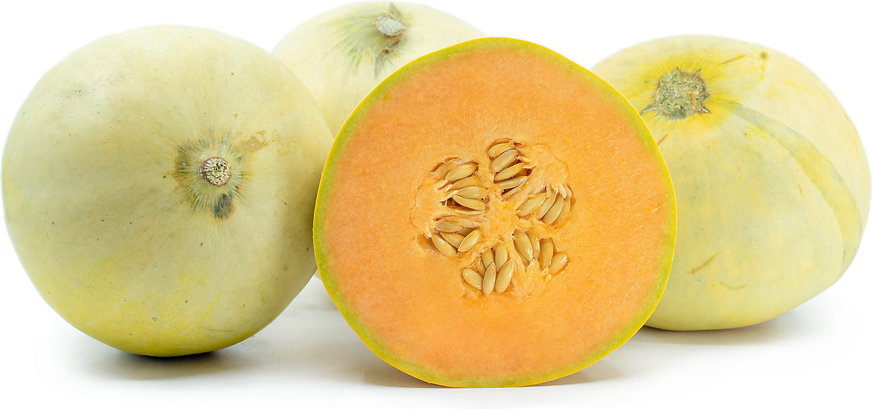


Honeymoon Melons
Estimated Inventory, ea : 0
Description/Taste
Honeymoon melons are a small varietal, averaging 11 to 12 centimeters in diameter, and have a round, ovate, to slightly oval appearance. The melon's rind is smooth, taut, and firm, showcasing shades of pale green to grey-green and is covered in tiny dark green flecks. Underneath the thin rind, the bright orange flesh is dense, aqueous, and succulent with a fine-grained and tender consistency. The flesh also encases a small central cavity filled with tapered, oval, ivory seeds suspended in orange fibers. Honeymoon melons should feel heavy for their size and will release an aromatic, melon-like aroma when ripe. The variety is grown in a specific way to concentrate sugars within the flesh, creating a refreshing, sweet, and floral flavor.
Seasons/Availability
Honeymoon melons are available for a limited season in the summer.
Current Facts
Honeymoon melons, botanically classified as Cucumis melo, are a sweet Italian variety belonging to the Cucurbitaceae family. The specialty melons are grown by one family in northeastern Italy and are a seasonal variety sold in limited quantities. Honeymoon melons are produced using traditional methods and are cultivated under rigorous standards to create a melon with natural but concentrated flavors. Every Honeymoon melon is planted in an open, untreated, and unsprayed field and is sold at peak ripeness to select markets through a partnership with the produce company Natoora. Honeymoon melons are favored by melon enthusiasts for their sweet and floral taste and are primarily consumed fresh to savor the melon's vibrant coloring, juicy flesh, and refreshing nature.
Nutritional Value
Honeymoon melons are a source of potassium to balance fluid levels within the body, vitamin A to maintain healthy organ functioning, and vitamin C to strengthen the immune system while reducing inflammation. The melons also contain high water content, contributing to keeping the body hydrated, calcium to build strong bones and teeth, and other nutrients, including B vitamins, phosphorus, iron, fiber, and folate.
Applications
Honeymoon melons have a concentrated, sweet flavor suited for fresh preparations. The melons are popularly washed and sliced into wedges, consumed straight out of hand. The sweet, juicy flesh provides a refreshing snack or simple dessert with enough flavor to stand by itself. Honeymoon melons can also be paired with fresh herbs in green and fruit salads, cubed and skewered on appetizer plates, or served with salty cheeses to create complex flavoring. One of the most traditional methods of serving the melons is wrapping them in prosciutto or other cured meats. The melons can also be incorporated into tomato or arugula salads, chopped into salsa, pureed and chilled into summer soups, or blended and frozen into popsicles, granitas, or sorbets. While less common, Honeymoon melons can be simmered into jams and preserves or served with savory dishes such as a topping on pizza, risotto, or pork rillettes. Beyond culinary preparations, Honeymoon melons can be pressed into juice and made into a meloncello, added to specialty cocktails, or blended into smoothies and shakes. Honeymoon melons pair well with herbs such as mint, basil, and cilantro, balsamic vinegar, cheeses including mozzarella, pecorino, and feta, cucumbers, tomatoes, and other fruits such as watermelon, pineapple, grapes, blueberries, and strawberries. Whole, unwashed Honeymoon melons will only keep for a few days when stored in the refrigerator. It is recommended to consume the melons as quickly as possible once ripe for the best quality and flavor.
Ethnic/Cultural Info
The Zerbinati family has spent generations growing exceptionally flavored melons on the floodplains of the Po river, the longest river in Italy. The floodplains contain mineral-rich clay soil that allows the Zerbinati family to regulate the amount of water given to the melon plants. Regulating water prevents the melons from absorbing too much liquid, diluting the flesh's flavor. Instead, the flavors within the flesh are concentrated, creating a rich, floral, and sweet taste. The melons are also covered in plastic to prevent rainwater from absorbing into the soil, further regulating the amount of water each plant receives. Beyond location, the Zerbinati family has focused on growing quality over quantity. Currently, melon production within the Zerbinati family is being led by Oscar Zerbinati. Oscar thins the number of melons on each plant, producing less than half the number of a conventional grower. The melons are also planted in succession for a more controlled harvest. Combining these specialized growing techniques has allowed the Zerbinati family to produce unique, complexly flavored melons.
Geography/History
Honeymoon melons are grown by Oscar Zerbinati, a specialist melon grower residing in Sermide in the province of Mantua in Lombardy, Northeastern Italy. Oscar Zerbinati comes from a lineage of melon growers, and Honeymoon melons are grown on the generational family farm. Once Honeymoon melons have reached maturity in the field, they are harvested and shipped to select markets and grocers through Natoora, a produce company focused on sourcing seasonal products. Natoora and Oscar Zerbinati have partnered for over seven years and have an exclusive partnership where Oscar sends the first of his melon harvest to Natoora. Today Honeymoon melons are available through Natoora locations in New York and Europe. The Honeymoon melons featured in the photograph above were sourced from Eataly in London, England.
Recipe Ideas
Recipes that include Honeymoon Melons. One
| Great British Chefs |
|
Chilled Melon and Olive Oil Soup with 'Nduja Toast and Oregano |




